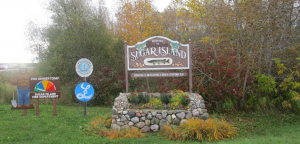Our study focuses on the birth, development, and integration of the Finnish community on Sugar Island, Michigan.
Sugar Island is an island located in the St. Mary’s River, which is the waterway by which Lake Superior, the largest freshwater lake in the Western Hemisphere, empties into the other Great Lakes and, ultimately, down the St. Lawrence River and into the Atlantic Ocean. There is a stretch of rapids on the St. Mary’s River, which the colonial French named Sault Ste. Marie. The settlement of Sault Ste. Marie, located at these rapids, dates its founding to 1668, when two French missionaries, Jacques Marquette and Claude Dablon, established a Jesuit mission at this site. Of course, French traders and indigenous people had visited the site earlier. The international border between the United States and Canada runs right down the St. Mary’s River. Presently, the American city of Sault St. Marie, on the Michigan side of the border, has approximately 13,000 residents. The Canadian city of Sault Ste. Marie, Ontario, has approximately 73,000 residents. There are still rapids at Sault Ste. Marie today, but this stretch of river is dominated by a system of locks that allow large ships to navigate into and out of Lake Superior. Here, at the locks, the water level drops about 6.5 meters over a 1.2-kilometer stretch of river.
Just south of the locks is Sugar Island, which is a township in Chippewa County, Michigan, the same county to which Sault Ste. Marie, Michigan, belongs. The island is approximately 26 kilometers (16 miles) long north to south and 13 kilometers (eight miles) east-to-west at its widest point. According to the 2010 census, it is home to approximately 700 permanent inhabitants and several hundred seasonal residents.
Sugar Island was part of a much broader territory occupied by the Chippewa (Ojibway) Indians. Historically, bands of Chippewa Indians hunted, fished, and lived around the Great Lakes in lands that are now part of the states of Michigan, Wisconsin, and Minnesota, and the Canadian provinces of Ontario, Manitoba, and western Quebec. The name of the island possibly comes from the Chippewa word Sisibakwato Miniss, “Sugartree Island.”
First Finns in Michigan
The first Finns in Michigan arrived in the 1860s, but significant immigration started in the 1880s. By 1920, the number of Finns in Michigan was 30,036 and, by 1940, the total Finnish population was 74,229, of whom 27,022 were foreign–born and 47,207 were native–born, according to the United States Census. In the early twentieth century, most of these Finns were living in in Copper Country, which is an area on the south shore of Lake Superior that includes the Keweenaw Peninsula and the land surrounding the base of the peninsula. Many of the Finns worked in the copper mines here. In addition to the mining industry, they worked in the forestry, fishing, and railroad industries. The first Finns to the Sault Ste. Marie area in the 1880s found work in the nearby lock. In later years, some Finns found work in the hydropower complex beside the locks.
Sugar Island and Finns
Frank Aaltonen was most likely the first Finn to move to Sugar Island. He moved there in 1916 and purchased land from the Chippewa Indians and started farming. According to the Federal census returns, most of the Finns living on Sugar Island in 1930 had left Finland between 1910 and 1911. Thus, they did not come directly to Sugar Island, but tried first to find a living elsewhere in the United States and Canada. The Finnish population on the island grew rapidly. The 1920 Federal census, which is only four years after Aaltonen arrived, shows total Finnish population as 102. Of these, 53 were born in Finland. While many of people living on Sugar Island were born in Michigan, some came via Canada, Minnesota, and one, Carl Lindburg (Kalle Lindberg), from Australia. By 1930 the number of Finnish-born residents had increased to 85 and the total number of people with roots to Finland was already 135. By 1940 their numbers had increased to 148, of whom 119 were born in Finland.3 Perhaps the reputation of Sugar Island as a good place to live was attracting people directly from the home country The U.S. authorities set up a quota of 529 Finnish immigrants per year in 1929, which may later have affected migration to Sugar Island.
Further Reading
Arbic, Bernard. Sugar Island Sampler. Allegan Forest, MI: The Priscilla Press, 2011 (orig. 1992).
Holmio, Armas K. E. History of the Finns in Michigan. Hancock: Finlandia University Press, 2001.
Kaunonen, Gary. Finns in Michigan. East Lansing: Michigan State University Press, 2009.
Kostiainen, Auvo (ed.). Finns in the United States: A History of Settlement, Dissent, and Integratio. East Lansing: Michigan State University Press, 2014.
Swanson, Allan A. Sokeri Saari: The Finnish Community on Sugar Island. Sugar Island: The Sugar Island Historical society, 2005.
